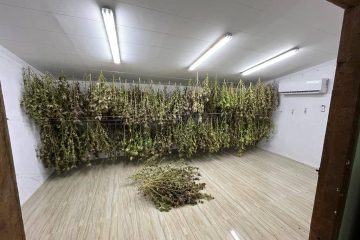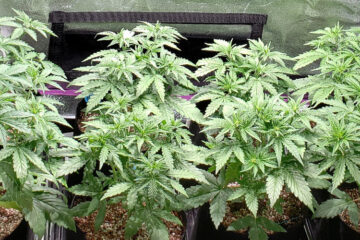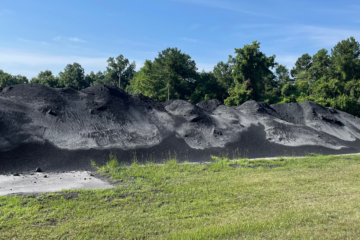Abnormal growth occurs on many plant species and cultivated crops when they are either infected by an infectious agent or mistreated by over-application of herbicides and other products. The specific cause of an abnormal growth is often perplexing and difficult to identify.
Even when a symptomatic plant sample is submitted to a diagnostic laboratory, the time and effort taken to figure out the cause can be significant.
If the Leaves of your Plants are not Very Green and Fat. This is the 1st Indication of a Problem.
Putting your Plants under a Tree to protect them from Elements. The Dripping of Water onto your plants from the Tree will transfer anything that the Tree has been infected with. Like Bacterial and Viral pathogens. Birds Fly from Tree to Tree.
This is a Primary reason to grow in a Controlled environment.
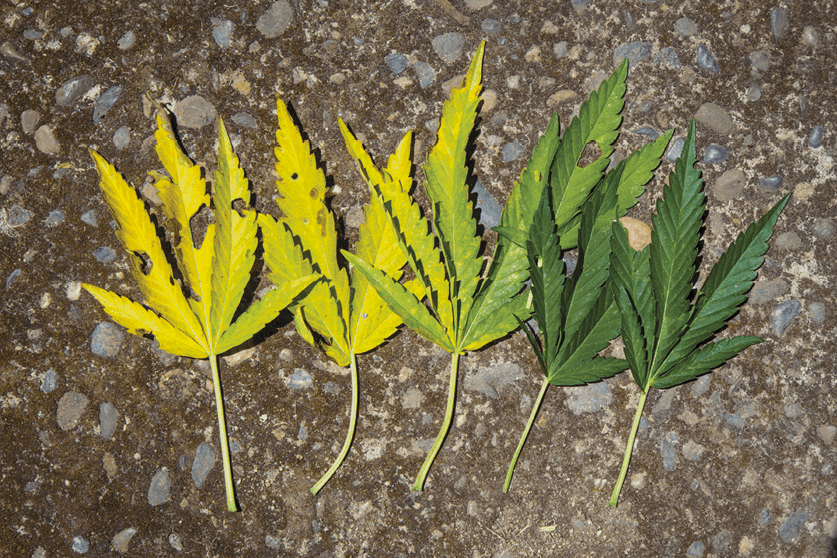
In Cannabis sativa plants, cannabis cultivators and hemp growers have observed various forms of abnormal growth, including excessive budding with underdeveloped leaves, leaf curling and thickness, wavy leaf surface, green islands on leaves (mosaic), shortened internodes, “witches’ broom,” chlorosis, stunting, or retarded growth.
The causes of some of these symptoms were only recently identified, and some are still unknown. Cannabis plants that have unexpected morphology often lack tissue-disruption disease symptoms such as canker, necrosis, and other forms of tissue decay, and they generally do not show evidence of fungal or bacterial growth.
This points to viruses and viroids as the main culprits of these abnormal growth symptoms.
Viruses, viroids, and phytoplasmas (a group of fastidious bacteria) mainly alter plant growth rather than kill cannabis plant tissue, partly because they depend on the host’s survival for their own; therefore, the symptoms these pathogens cause are significantly different from those caused by fungal and non-fastidious bacterial pathogens, which usually kill host tissue and use its nutrients to thrive.
Here are four culprits of some of the most common cannabis and hemp diseases that alter growth, and how to recognize, diagnose, and prevent these viral diseases and bacterial contaminants in both indoor-grown cannabis plants and field-grown hemp crops.
Pathogen: Hop latent viroid (HpLVd); Primary symptom: Plant stunting
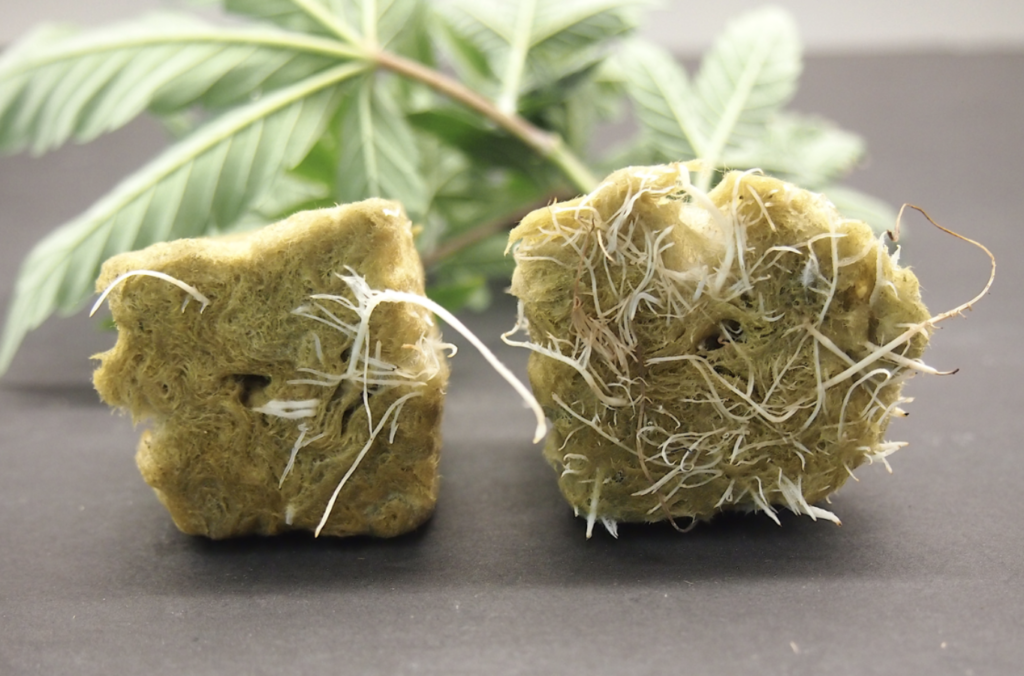
Hop Latent Virus affecting Clones
Root length and root emergence are greatly reduced in clones taken from HLVd-infected mother plants. This reduction in root development results in slower-developing clones and poor-quality rooted cuttings. Reduced root development may also make plants more susceptible to root-infecting pathogens, such as fusarium and pythium.
Several reports have suggested that hop latent viroid (HpLVd) is associated with a stunting disease in Cannabis sativa. Cannabis plants infected with this viroid may exhibit leaf chlorosis, malformation, brittle stems, reduced flower mass and trichomes, and overall stunting.
If indoor cannabis plants show these symptoms, growers may want to consider a test for HpLVd. In hemp crops, however, these symptoms are not unique enough to warrant an HpLVd test, as other viruses can cause similar symptoms. In certain cases, mild phytoplasma infection can result in stunting and malformation.
Therefore, the diagnosis of a HpLVd infection requires a holistic approach, and sometimes multiple tests or high throughput sequencing may be performed to confirm which virus or viroid is infecting. HpLVd infects hops without symptoms, but infected cannabis plants are often stunted.
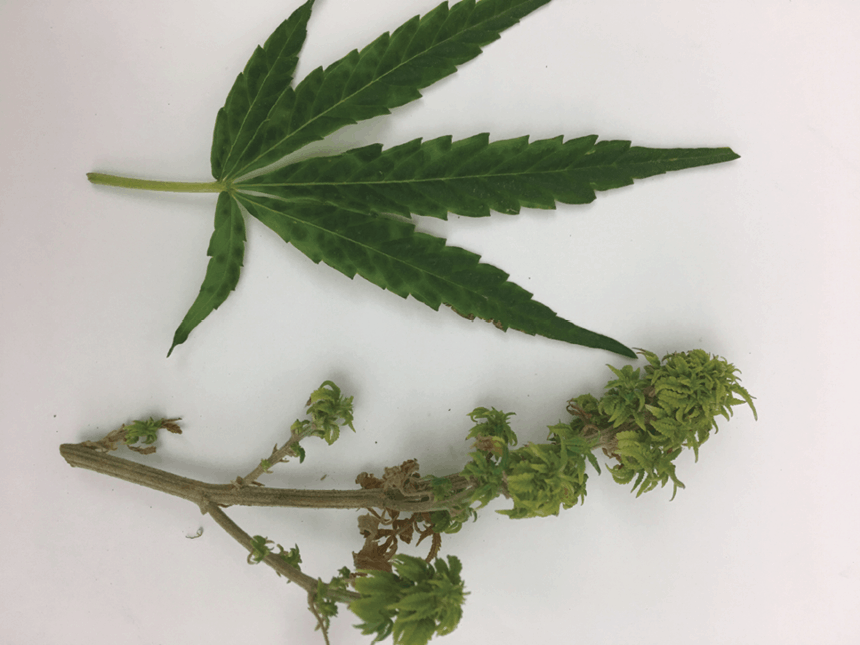
HpLVd can be transmitted from plant to plant by mechanical means and also via seeds. And also Transmission handling diseased Plants without proper protocols in Place. Always wash your hands and change clothes before moving on to Greener Healthy Plants.
Therefore, indoor cannabis producers can reduce the likelihood of mechanical transmission by practicing strict plant handling protocols, such as sterilizing trimming scissors after use on each plant, limiting the number of staff members interacting with plants in different areas, and washing hands with soap before and after handling plants.
Field-grown hemp producers can avoid HpLVd by ensuring seeds are healthy, certified, or tested confirming they are free from this viroid. Fig. 2. Hemp witches’ broom
Pathogen: Lettuce chlorosis virus (LCV); Primary symptom: Leaf chlorosis
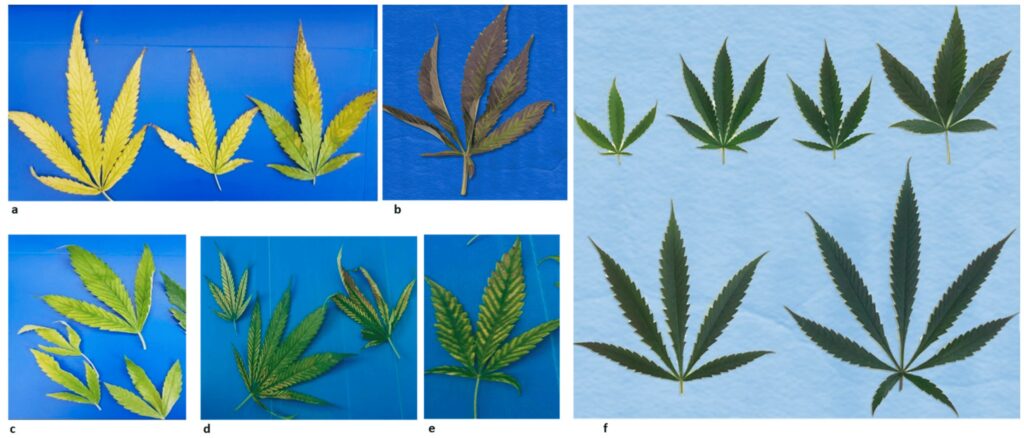
Disease symptoms of lettuce chlorosis virus on old leaves of cannabis plants at the vegetative stage. (a) Yellowing leaves showing necrosis. (b) Purple leaves. (c) Chlorotic leaves. (d) Interveinal yellowing leaves showing necrosis, (e) Interveinal yellowing leaves. (f) Cannabis leaves of uninfected ‘healthy’ leaves.
Lettuce chlorosis virus (LCV) has been detected from Cannabis sativa plants.. It causes yellowing, chlorotic, and necrotic foliage. Infected leaves may also exhibit thickness and brittleness.
The sweet potato whitefly (Bemisia tabaci) Middle Eastern Asia Minor1 (MEAM1) biotype can transmit the virus from infected cannabis plants to healthy ones in a semi-persistent manner as the virus can remain in the whitefly’s gut without circulating through its body.
This can be a major means of virus transmission in fields where the whitefly feeds on an infected plant, carries the virus in its stomach, and releases the virus to a new plant when it feeds on that one. Therefore, preventing this pest in the field and greenhouse is key. Controlling weeds is also important, as many weeds host LCV and serve as natural reservoirs of the virus.
Shoots from infected plants, especially mother plants used for propagation, can be a primary source of infection for indoor cultivation, and routine tests for LCV from mother plants can significantly reduce the disease incidence in a crop. LCV does not spread via cannabis seeds.
A diagnosis of LCV infection based solely on symptoms is difficult, as many viral diseases have similar symptoms, especially when co-infections with different viruses occur. A reverse transcription polymerase chain reaction (RT-PCR)-based molecular test can quickly detect if this virus is present in plant tissue.
Yellowing, chlorotic, and necrotic foliage can be a symptom of stem or root disease, so growers should examine stems and roots closely for disease symptoms before confirming a leaf disease.
Pathogen: Beet curly top virus; Primary symptom: Leaf curl

Drape this plant in Plastic. Using Snips preferable over a saw. Cut it and remove it to your Burn Pile! Throw the plastic and the Plant into the Fire.
Symptoms are variable and depend on plant variety and growth stage, temperature, and virus strain. The predominant symptom is stunting, leaf curling or twisting, and a pale-green-to yellow coloration of foliage. Leaves may exhibit puckering and upward curling or may remain green with a twisting of new growth and stunting of stem growth.
In general, disease symptoms are more severe if plants are infected with BCTV in earlier growth stages. In some instances, plants can exhibit symptoms which they then appear to “out-grow” or individual plants may contain a mixture of symptomatic shoot portions along with “healthy.”
Beet curly top virus (BCTV) has been detected in hemp crops in several U.S. states and has caused significant damage—and total loss in some cases.
Infected plants exhibit a variety of symptoms, but commonly present with leaf rolling and, in almost all cases, leaves roll upward instead of downward (see Fig. 1, above). Leaves of infected plants may be faded green or partially yellow. Older leaves may roll upward slightly, and the undersides of leaves can appear silver; some may appear thicker than normal with a wavy or malformed upper surface.
Newly grown leaves are generally narrowed and curled with a slightly faded green color. Severely infected plants are stunted with notable curled and distorted foliage.
These symptoms occur throughout the vegetative and flowering stages, but they are often noticeable during the middle of season. However, a plant infected with BCTV may not show obvious symptoms depending on the growth stage at which the virus infects the plant.
Or, the plant may recover from the symptoms, even though it still contains the virus. Environmental conditions, host varieties, and virus strains can determine whether plants develop and/or recover from the virus. Although these symptoms are characteristic, a definite diagnosis requires a lab test, such as a viral DNA-based molecular test.
BCTV is a well-known plant virus that affects many crops, including sugar beet, tomato, and pepper, and it is mainly transmitted by the beet leafhopper, an important pest in the western United States. A significant percentage of leafhoppers carry this virus, and therefore this insect plays a critical role in spreading the virus from one crop to another.
Because of this, hemp leaf curl is prevalent mainly in outdoor hemp fields. However, the insects may not always be detected when plants start to show symptoms, as they may have already migrated from the field after transmitting the virus.
There are many weeds that can be infected by BCTV and also serve as efficient food sources for leafhoppers; therefore, weeds control is important to prevent leafhoppers from acquiring the virus and then transmitting it to hemp. In contrast, indoor cannabis plants are less likely to be infected with BCTV due to the absence of the insect vector and weeds.
Pathogen: Phytoplasmas (‘Candidatus Phytoplasma trifolii’); Primary symptom: Branch clusters, known as witches’ broom
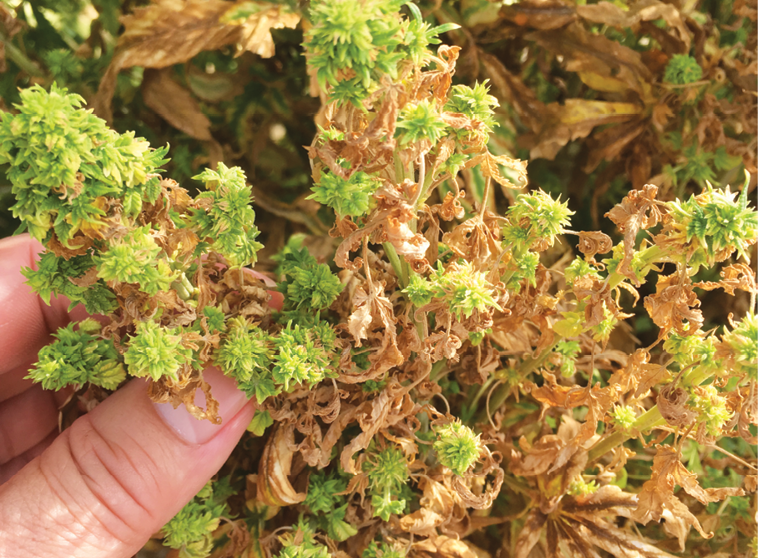
Phytoplasmas are bacteria that live in insects and plant phloem, or the living tissue that transports important resources like sugar. Unlike non-fastidious bacteria, which are culturable on growth media and generally cause plant tissue decay, phytoplasmas are phloem-limited parasites and mainly cause significant alteration of plant growth and development.
Typical symptoms include clustering of little branches (witches’ broom), phyllody (developing floral organs on leafy structures), greenish pigmenting in non-green flowers or shoots (virescence), and yellowing and stunted plants.
In certain varieties of hemp, phytoplasma-infected plants develop clusters of highly proliferating branches with significantly shortened internodes (Fig. 2, above). Leaves in a cluster are tiny, crowded, sometimes yellowish. Leaves outside the cluster turn yellow and sometimes are deformed. Early infected plants may be severely stunted when compared to a normal plant. Young plants may die off during the early season
Phytoplasmas generally are transmitted by phloem-feeder insects in the order Hemiptera, particularly leafhoppers, planthoppers, and psyllids. Inside the insect vector, phytoplasmas can survive and are stored in the guts and salivary glands, with the ability to move to the saliva.
When a phytoplasma-carrying vector feeds on a plant, it delivers phytoplasmas into the phloem via saliva. Therefore, the host range of a phytoplasma largely depends on the plant feeding range of its vector, which is generally broad.
One of the most effective practices to manage phytoplasma diseases is to periodically monitor and control insect vectors, especially leafhoppers, which can also help mitigate hemp leaf curl caused by Beet curly top virus. Although phytoplasmas are mainly transmitted through leafhoppers, they can also be spread via propagation materials such as cuttings and seeds.
This is a primary reason to have a Clean Workspace, Sterilizing your tools being used and as sterile of an environment as possible when making Clones!

Therefore, mother plants should be periodically tested for the phytoplasma to prevent the dissemination of the disease to progeny plants. Seeds should be tested and verified to be free from phytoplasma infection.

The infected bud does look frosty in this picture, but the lack of density and high amount of vegetative growth is evident.
Generally, Phytoplasma diseases are controlled by preventing infection through insect control. Some phytoplasmas can be seed transmissible, but this has not been demonstrated in Cannabis. Phytoplasma diseases may be able to be controlled through application of antibiotics such as tetracycline and rifampicin [26], but these are not approved for commercial production anywhere that I am aware of.
A plant genotype can be recovered through meristematic tissue culture, but once infected, a plant will not produce well or have marketable bud.
In short, viruses, phytoplasmas, and viroids are mostly controlled through prevention and include virus free seed, tissue cultured clones, and insect control. One a plant has one of these problems, it will not be able to be treated and will not be worth producing with. In fact, it is important to cull any plants you find with these symptoms unless you want to preserve the plant’s genetics, in which it may be worth having the plant go through tissue culture.
Correct Diagnosis
The virus, viroid, and phytoplasma all infect cannabis plants systemically and induce abnormal growth. Although symptoms caused by each organism are distinct to some extent (for example, witches’ broom is more likely to be caused by a phytoplasma infection, leaf curl by Beet curly top virus, foliar chlorosis by Lettuce chlorosis virus, and stunting by Hop latent viroid), there are significant overlaps in symptom development among these diseases.
One pathogen can cause multiple symptoms that may resemble other diseases and, in some cases, a crop can be infected by multiple pathogens.
To correctly diagnose complicated and overlapping abnormal-growth diseases, one can perform a symptom polling in the field to determine the prevalence of each symptom type by referencing what the polltaker sees to each typical symptom caused by phytoplasma, virus, or viroid.
This is primarily why you see Big Grows being maintained by individuals that look like Scientist. These are actually Workers that are following proper Operational Procedures.
When your Boss has Millions invested. And perhaps your Grow consist of a few Thousand Plants. Along with Years of Hard work in Breeding and Plant Selection (Phenotypes) Then yes. SOPs become extremely Important.
Before I hire anyone, I learn what they know about Integrated Pest management and what are some Standard Operating Procedures. IPM and SOP.
Knowledge is Power and the Key to Success!! I know!
Kevin
